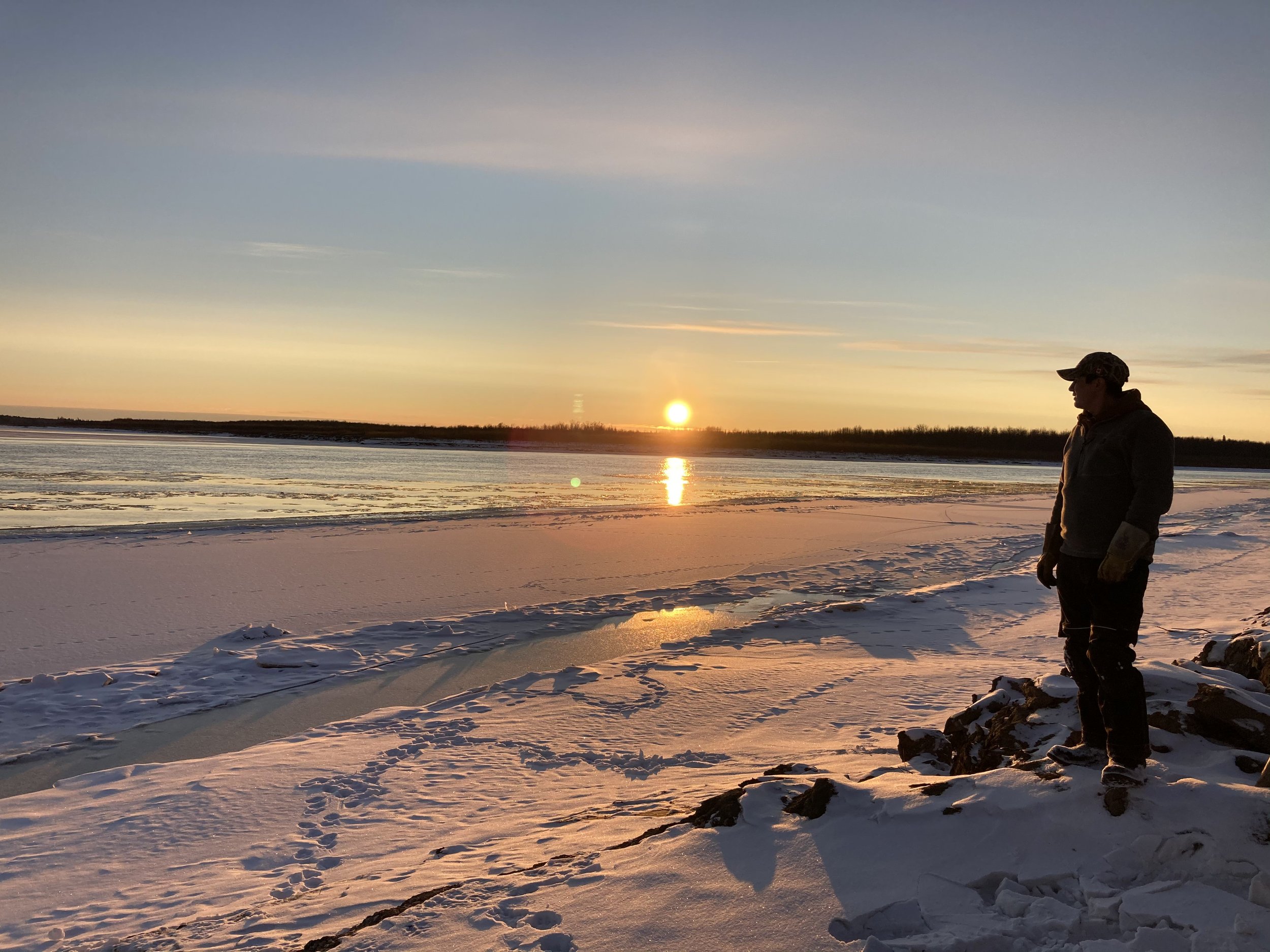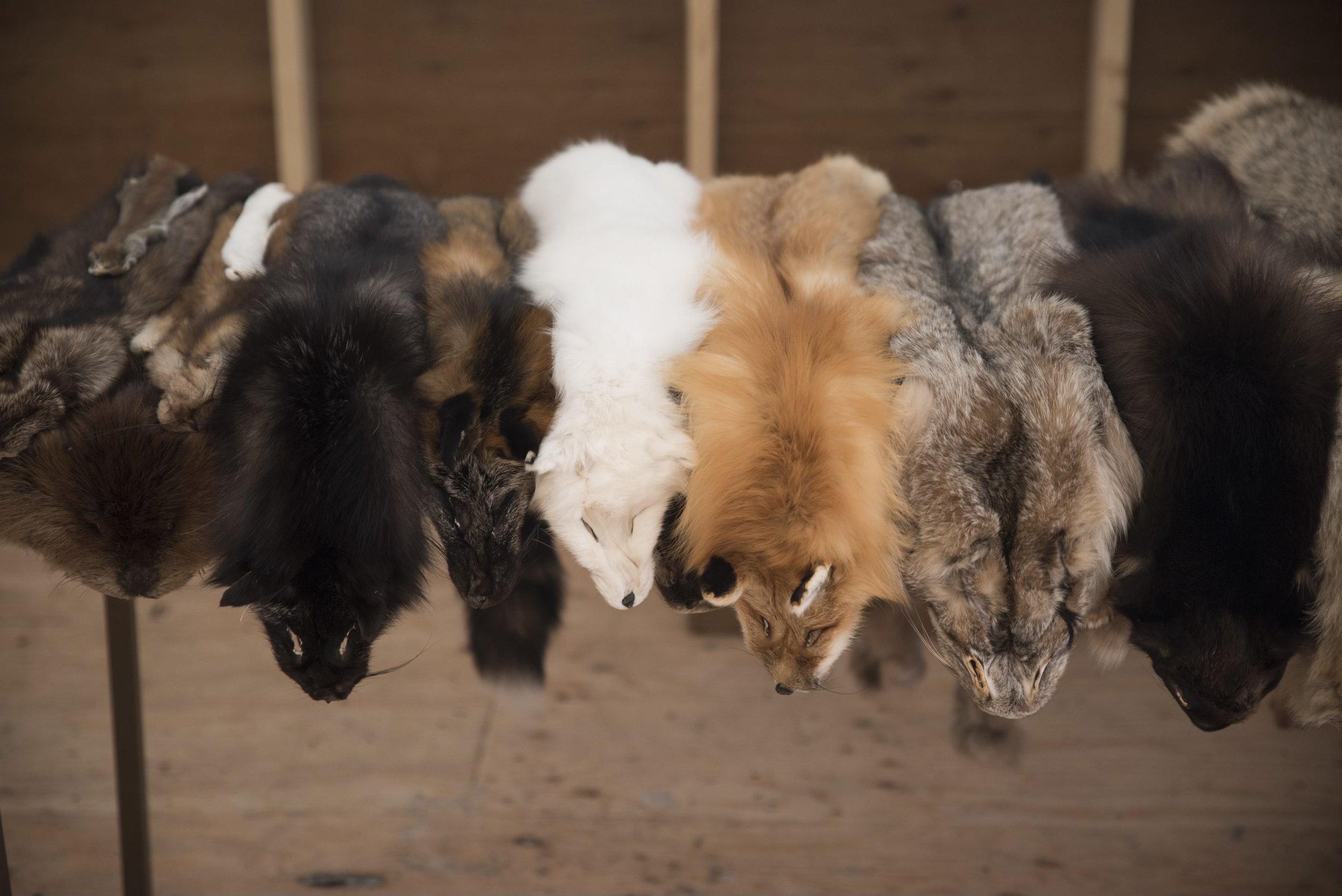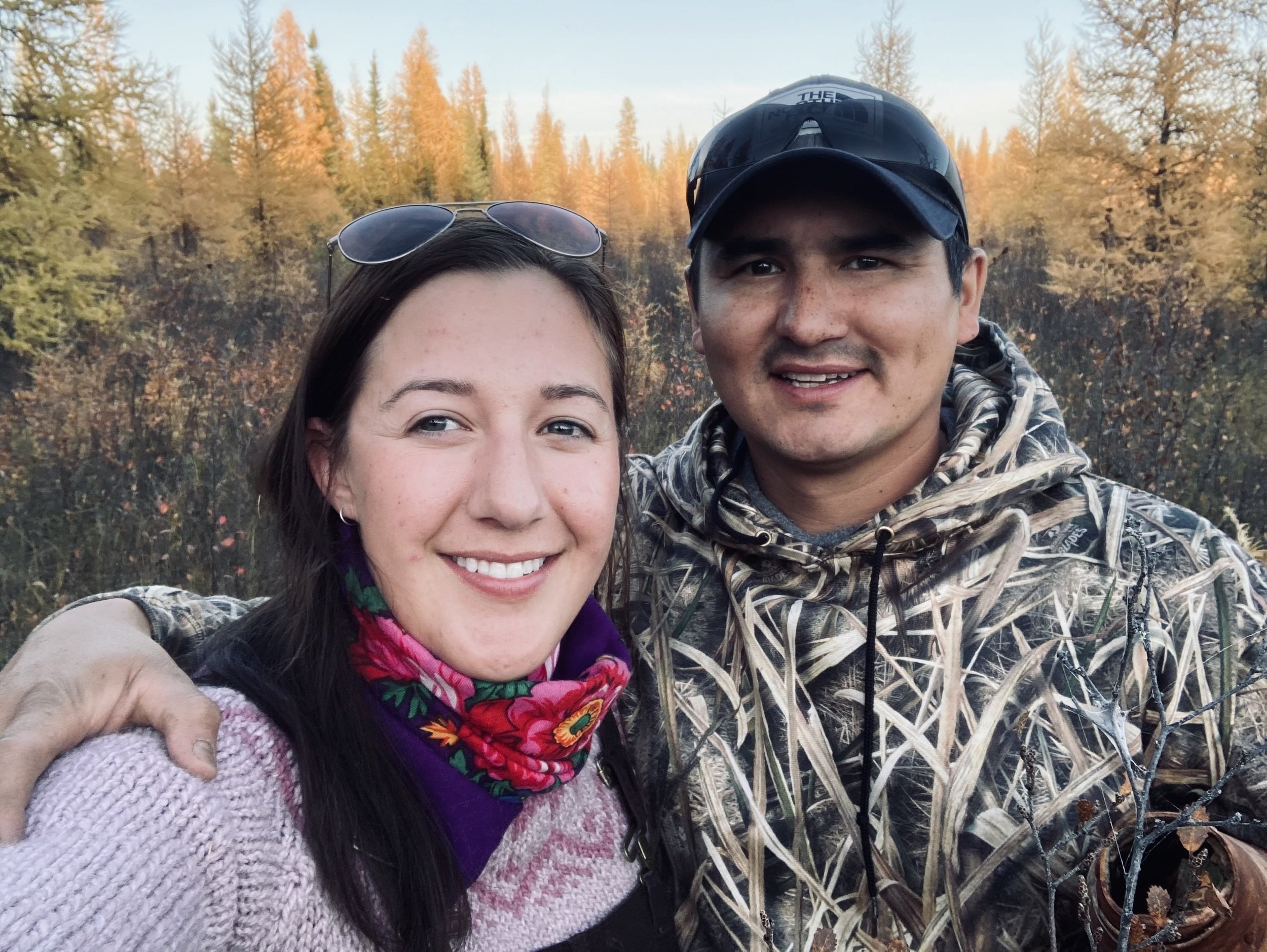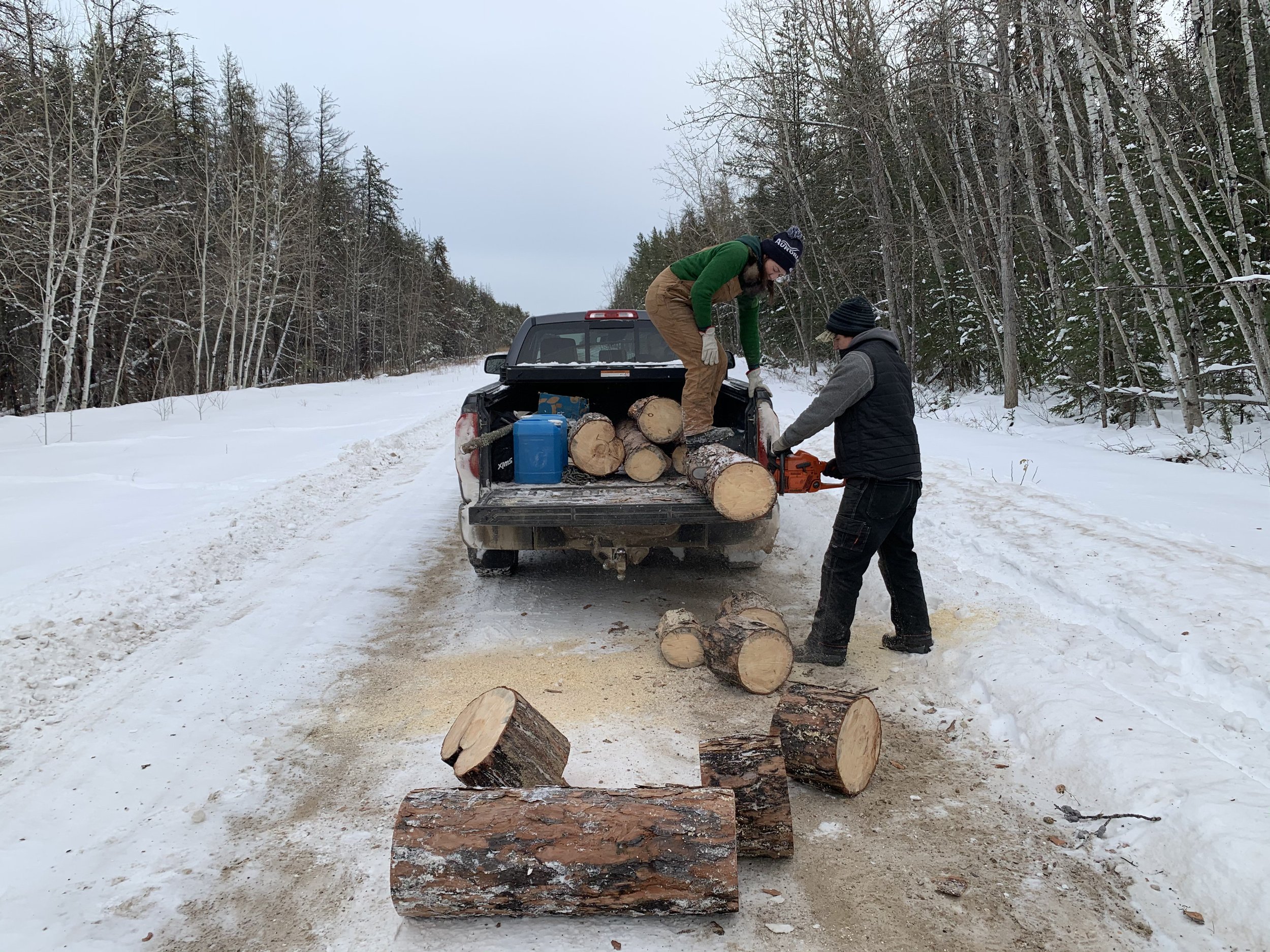
You can find us following the rhythms of the Land at any time of the year
Our schedule is always dynamic, and dependent on what the Land is telling us. Click on each month for information about where to find us each season, and the best times for us to support certain activities.
-
In January, we are on the trapline. January is a busy month for trapping wolverine, wolves, marten, fisher, lynx, mink, foxes, weasel, and squirrel. We are very busy during this time.
Winter is normally consistently cold and by January, animals are in a routine of survival. When you have fluctuations of temperatures like we have been seeing in the last decade or two due to climate change, rain or warm days can cause impacts like hard crust on top of the snow, affecting both prey and predators and interrupting cycles.
For instance, a ptarmigan or grouse will roost in the snow for insulation. A hard layer means that they will have to endure the cold and be exposed to elements and predators, lowering their survival rate. Foxes dive into the snow for voles and mice, and must adapt hunting methods that are crucial to their survival rate. Ungulates cut their ankles on icy crust which gives wolves and coyotes an advantage.
Changing weather patterns cause a cascade of impacts that affect everyone on the Land, including us. We are neither above nor below the other beings around us, rather we are affected by the same factors and part of the same web, playing our role as best we know how and respecting the roles of others. It is our responsibility to be present as much as possible so that we understand the best ways to contribute. -
The first half of February continues to be a busy month for trapping wolverine, wolves, fisher, lynx, mink, foxes, weasel, and squirrel.
We trap until the Land shows signs of breeding and reproduction. It is important to listen to the Land instead of following regulations and set dates that do not stay the same from season to season. Natural laws are the laws that we follow. Each year is different, and each day is different. The only way to know, is to be out on the Land experiencing it and participating in the change.
The second half of February is generally spent finalizing the processing of animals caught during trapping season. This is a good time to engage us for skinning and processing demonstrations, as we can store animals outside in the cold weather, and we still have many furbearers to process. -
The warmth of the sun comes back in March, daylight hours start to increase and days are temperamental, either warm or cold. This is the time for trapping beavers and muskrats, as they are full grown adults and their fur is thick and dense from the winter cold. It is also our time to relax after a busy winter trapping season. We stop hunting rabbits and grouse as they are beginning to breed. In a good season, rabbits should have 3 litters over a summer season, with the first litter having one of their own in August.
After a compact harvesting season, we clean up camp and return carcasses to the Land as our way of participating in reciprocity. In this critical time after a hard winter and as animals prepare to have young, this influx of food helps to secure survival for the next generation. This is a key piece of how we work to maintain cycles and abundance on the Land.
March continues to be a good time for skinning and processing demonstrations for NWT furbearers as the weather is cold enough for storage, and we are still processing fur. -
April is a month of transition in the North. Temperatures are warming, and ungulates are almost ready to have their young. Bison are migrating from the lowlands to higher areas. Bull moose can be found in poplar and birch stands, replenishing their nutrients after a hard fall rut and long winter. Cow moose are trying to wean their calves from the previous season, in order to have new young in May. If a mother isn’t able to wean her calf, the new calf is at risk of being killed by the older calf. Older cows are more experienced and effective at this process. Many furbearers are denning and storing food in order to raise their kits and pups. Bears and other hibernators like groundhogs, chipmunks, and skunks begin emerging from their dens and moving around. Bears are an important indicator for transition, and we watch their behaviour closely over the spring months.
We often take a week in April to travel for a waterfowl harvest in the south about a month before the birds migrate north. Because the birds are so concentrated on the prairies, this trip allows us to scout and evaluate the health of populations before they reach the north. Agriculture has had significant impact on waterfowl behaviour and migration. This is the time to engage us with anything to do with geese or ducks! It is also a good time for us to travel for workshops or presentations in person. -
The river ice generally breaks up at the end of April/early May, and open water activities can begin. May tends to be a very busy month!
We usually do a big harvest of beavers and muskrats, as well as geese, ducks, and swans. Beavers and muskrats begin to fight soon after the river opens, which is the sign of them starting to breed. We can tell the difference between inland beavers that travel to the river and local river beavers by the width and size of their tails. We also distinguish the sex of the beaver as it swims in the water, which allows us to prioritize the harvest of males, leaving females to carry on the population. Spring hunt for beavers and muskrats is a very narrow window, and to understand this cycle it is important to be present and witness the transition. Once again, dates don’t dictate the transition – it is different every year.
Bird migrations are a beautiful sequence that share intricate information about the Land. Staying present and paying attention gives us an indication of what the Land is doing both north and south of us. Canada geese are first to arrive, followed by mallard ducks. Trumpeter swans are soon to follow. At the sign of pintails, widgeons, and spoonbills; lesser Canada geese, speckle bellies, snow geese, and sandhill cranes will follow shortly after. The last migrators are usually the ross geese, also called galutes.
May is also the month for tapping birch trees. Just like the well-known maple, white birch secretes sweet water that can be rendered into a tasty syrup. We also drink the water to replenish our nutrients and align with spring. Due to melt and increased flow, river water is murky at this time and so birch water provides a clean and fresh source for drinking. Wind stimulates trees during the spring months, and after a windy day we find the trees produce the most water. Once birch starts to bud, the water becomes bitter and cloudy and we are happy to close up the trees, always sharing offerings and thanks.
We cannot overstate the importance of presence and observation during this time. There are many cues on the Land in the spring that allow us to predict what the following fall and winter seasons will offer. This is why being present on the Land through all seasons is significant to a balanced and holistic lifestyle for us. -
June is garden planting season and a great time for processing beavers and moose hides before the heat of the summer. The fleshing and scraping portion of hide tanning is important to get done at this time. This is hard work that is not comfortable to do in the heat of the summer. As well, flies are still at bay in early June and not active at night and so it is vital to finish the bulk of the processing before the heat creates the conditions for larvae to thrive. This is also a good time for fishing, dry fish making, drymeat making, filleting pickerel, and picking eggs (ducks, geese, and seagulls). When picking eggs early in the season, you can take a clutch up to three times before it will impact the population – the birds simply lay more eggs. Before harvesting an egg, we test them in the water to see if the embryos are developing.
We do not normally harvest black bears in the spring, unless they are posing a threat around camp. Bears emerge in a hungry state in early spring. They start by eating early shoots of grass and poplar buds high up in the canopy. They are generally cautious and respect the boundaries of human presence, so if they are coming into camp in June, we recognize that they are desperate and the conditions on the Land are not operating in sequence. -
July in our area is hot, muddy, and buggy. We spend our time in July maintaining camp and taking care of the garden. This is a good time for outdoor shows and festivals, and a bit of traveling. Our biggest challenge is keeping our food reserves frozen, and so watching the freezers is important. Keeping camp clean to avoid run-ins with bears is essential during the summer as well. July can be an opportunity to harvest a bull moose when their meat is the sweetest from plentiful summer greens. In the heat, it is critical to process any meat quickly before it spoils. The richness is blood in a bison is not comparable to a moose, and a bison would spoil too quickly at this time – whereas moose and bear are possible to work with.
-
As the summer comes to a close, cooler temperatures start to bring us back to life! August (particularly the end of the month) is a good time to work on moose hides. Moose hunting may start around the end of August as well and we spend time picking medicines, berries, and mushrooms. Cooler temperatures mean we can begin to refill our food stores for winter, and this is a good time to fish. One indicator for fall is the migration of sea ducks like the surf scoter. Once we see them pass through, we know it is about two weeks before the big fall migration happens.
At the end of August and in early September, we harvest black bears. By this time, they have developed fat reserves which are indicative of the success of the berry season. We use bear fat for cooking and baking throughout the year. We also eat bear meat and tan the hides, so there is much use for fall bears. -
As fall starts to take hold, the Land gets very busy! Ducks and geese start migrating back south, moose go into the rut, and plants fully mature before the winter. September activities include: moose hunting, processing moose hides, hunting for geese and ducks, harvesting and preserving the garden (canning and freezing), and picking medicines and berries.
We can look for signs of approaching cold as beavers begin to stockpile food. Inland beavers stockpile food earlier as the small lakes freeze quicker than the flowing water of the river. We are starting to watch beavers closely, as we will harvest them in large numbers just before the ice freezes, when their pelts are thickest.
September tends to be the heaviest month of migration for waterfowl. Adult birds come first and are followed by juveniles after a few weeks. We start to hunt grouse again and can tell the success of their breeding season and the state of the summer season by the size of their clutches at this time. If it was too dry or too wet, we may see impacts on grouse population, which will have implications for us as well as other predators.
As fall progresses, we are preparing for the final fall harvest of many animals before winter sets in. Just like the beavers, it is time for us to stockpile for the cold months. Through hunting and the harvesting, we show love and respect for animals and plants. When we harvest a moose for instance, we spend time and care on the hunt, the skinning, the butchering, and the processing. When we eat the meat, we speak the name of the moose with praise and love as it nourishes us all winter long. We do all we can to ensure that moose populations are healthy, because we rely on the gifts from moose to survive. We spend our lives intertwined with them, understanding them to the full extent we can. The continued effort to maintain relationship with the nation of moose is of utmost importance to our survival and the survival of the moose – true reciprocity. -
Fall is a transitional and busy time. October is an important month to prepare our camp for winter. We continue to hunt moose, geese, ducks, swans, and grouse – but now it is also time to hunt beavers and muskrats in open water before the ice freezes.
By late October, moose are in full rut and so by this time, we hopefully have been successful in our harvest of meat for the winter. We don’t normally hunt bull moose after the first week in October, as their meat changes taste and quality. During the rut, bull moose do not eat for weeks and they are single minded to finding cow moose and breeding. They pee on themselves to create scent, and they fight with other bulls.
Before the river freezes in late October/November, we travel around the rivers and creeks analyzing the state of muskrats and beavers after the summer. This gives us an indication for harvest in fall, winter, and spring. One of the major contributors to the survival of beavers and muskrats is the unknown and unnatural fluctuation of water from hydro dams upstream. Lodges that they build over the summer to prepare for a long winter are hugely affected by this change in water level. We frequently see lodges that are exposed too high on the bank, as the water level has drastically decreased in a short period of time, leaving no time to rebuild and store food. This means the beavers are forced to move, and often perish. If they move to other territories, they have to contend with the resident beavers and end up causing fighting. The fall harvest of beavers tells us much information about these interactions. Injured beavers with scars and sores tell us that the river has not been stable. -
In November, the river generally freezes up. This is the last opportunity for waterfowl hunting before the birds fly south. Once again, we can tell a lot of information from the sequence and timing of the migration. Trumpeter swans are the last migrators to come through and with the big white whoosh of their wings, we have seen the last of the birds until spring.
Mornings are frosty and the winds bring early snow, wet and melting at first but eventually staying on the ground. This is the month where fall turns to winter, and we adapt to the season – putting our fall clothes away into storage and bringing out our big winter jackets and fur.
We are still hunting grouse, and we start to trap martens and squirrels. If the freeze up is late, we trap by boat on the river until the river is no longer passable. Many times we have been on the river as it begins to freeze, first with a film on top We then have a waiting period until the ice is thick enough to access by snowmobile. We spend that time preparing traps, bait, and supplies for the busy trapping season to come.
November can be a good time for travel for in-person presentations and demonstrations with fish, birds, and moose. -
December begins the first month of busy trapping, and you can find us travelling across the Land cutting roads to travel by snowmobile for the winter; trapping wolves, marten, fisher, lynx, wolverine, squirrel and weasel. December is a hard month for animals on the Land, especially the young ones. Many perish in the first cold snaps of winter, due to inexperience. As trappers, we do our part to make room for healthier animals to survive the harsher seasons.
For example: if you have 100 rabbits and 20 lynx and a lynx eats a rabbit every day, it will last 5 days. If you trap 10 lynx out of those 20, you’ve extended the food source for the population and you will have 10 healthy lynx, instead of 20 starving lynx that will all struggle to survive. Healthy animals with a consistent food source will reproduce, while struggling ones tend to hold off pregnancies for easier times. In this way, we help to ensure the next generation.
As Indigenous trappers, we are not collecting pelts for a monetary gain. We trap all species, regardless of the market prices. This allows us to see a holistic picture, building our overall knowledge of what is happening on the Land. Everything and everyone is always in flux, and to have any understanding takes effort, commitment, and dedication to be present and harvesting.
Trapping is much more than going out during the winter season to set traps. Spring, summer, and fall months are essential for the story of the Land. Food sources, weather trends, population numbers, and environmental factors like forest fires, industrial impacts, and climate interruptions are all pieces of a puzzle that add up to increase our understanding. Putting the pieces together is ultimately a matter of survival for us. Every piece of information that the animals tell us helps us to know our environment, conditions, and how to react to be successful. We eat the meat from animals that we catch, we use fur for warmth in our cold climate. Like all other animals, we share in the web of abundance and interdependence to thrive.
JANUARY
FEBRUARY
MARCH
APRIL
MAY
JULY
AUGUST
JUNE
SEPTEMBER
OCTOBER
NOVEMBER
DECEMBER

Our work and availability are seasonal.
For more information on booking our services, please contact us and we’ll get back to you as soon as we can.












